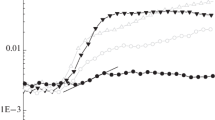Abstract
The powerful solar flares that occurred on September 4–10, 2017 are analyzed based on a quantitative diagnostics method for proton flares developed at the Institute of Terrestrial Magnetism, the Ionosphere and Radio-Wave Propagation (IZMIRAN) in the 1970–1980s. We show that the fluxes and energy spectra of the protons reached the Earth with the energies of tens of MeV qualitatively and quantitatively correspond to the intensity and frequency spectra of the microwave radio bursts in the range of 2.7–15.4 GHz. Specifically, the flare of September 4 with a peak radio flux S ~ 2000 sfu at the frequency f ~ 3 GHz (i.e., with the soft radio spectrum) was accompanied by a significant proton flux J (>10 MeV) ~100 pfu and a soft energy spectrum with the index γ ~3.0, while the strong flare on September 10 with S ~ 21000 sfu at f ~ 15 GHz (i.e., with the hard radio spectrum) led to a very intense proton event with J (>10 MeV) ~1000 pfu with a hard spectrum (γ ~ 1.4), including the ground level enhancement (GLE72). This is further evidence that microwave radio data can be successfully used in diagnostics of proton flares independently of a specific source of particle acceleration at the Sun, in particular, with the IZMIRAN method.
Similar content being viewed by others
References
Akinyan, S.T., Fomichev, V.V., and Chertok, I.M., Determination of the parameters of solar protons near the Earth according to radio bursts, 1. The intensity function, Geomagn. Aeron., 1977, vol. 17, no. 1, pp. 5–8.
Akinyan, S.T., Alibegov, M.M., Kozlovskii, V.D., and Chertok, I.M., Quantitative identification of proton flares from the characteristics of microwave radio bursts on frequencies of about 9 GHz, Geomagn. Aeron., 1978, vol. 18, no. 3, pp. 275–278.
Akinyan, S.T., Fomichev, V.V., and Chertok, I.M., Results of qualitative diagnostics of proton flares according to data on radio bursts for the control interval of 1970–1977, Geomagn. i Aeron., 1980a, vol. 20, no. 3, pp. 385–393.
Akinyan, S.T., Chertok, I.M., and Fomichev, V.V., Quantitative forecast of solar protons based on solar flare radio data, in Solar–Terrestrial Prediction Proceedings, Boulder, 1980b, vol. 3, pp. D14–D26.
Akinyan, S.T., Fomichev, V.V., and Chertok I.M., Estimates for parameters of proton fluxes from radio burst characteristics at frequencies of 15–19 GHz, Phys. Solariterr., 1981, no. 17, pp. 135–143.
Anastasiadis, A., Papaioannou, A., Sandberg, I., Georgoulis, M., Tziotziou, K., Kouloumvakos, A., and Jiggens, P., Predicting flares and solar energetic particle events: The FORSPEF tool, Sol. Phys., 2017, vol. 292, no. 9, id 134.
Aschwanden, M.J., The localization of particle acceleration sites in solar flares and CMEs, Space Sci. Rev., 2006, vol. 124, nos. 1–4, pp. 361–372.
Bazilevskaya, G.A., Sladkova, A.I., Fomichev, V.V., and Chertok, I.M., Possible relationships between solar proton fluxes in interplanetary space and the formation of a postflare loop system, Soviet Astronomy, 1990, vol. 34, no. 2, pp. 205–210.
Belov, A., Garsia, H., Kurt, V., Mavomichalaki, H., and Gerontidou, M., Proton enhancements and their relation to the X-ray flares during the three last solar cycles, Sol. Phys., 2005, vol. 229, no. 1, pp. 135–159.
Chertok, I.M., Estimates for the index of proton energy spectrum according to solar microwave flare data, Geomagn. Aeron., 1982, vol. 22, no. 2, pp. 182–186.
Chertok, I.M., On the correlation between the solar gamma-ray line emission, radio bursts and proton fluxes in the interplanetary space, Astron. Nachr., 1990, vol. 311, no. 6, pp. 379–381.
Chertok, I.M., Post-eruption particle acceleration in the corona: A possible contribution to solar cosmic rays, Proc. 24th ICRC, 1995, vol. 4, pp. 78–81.
Chertok, I.M., Grechnev, V.V., and Meshalkina, N.S., On the correlation between spectra of solar microwave bursts and proton fluxes near the Earth, Astron. Rep., 2009, vol. 53, no. 11, pp. 1059–1069.
Desai, M. and Giacalone, J., Large gradual solar energetic particle events, Living Rev. Sol. Phys., 2016, vol. 13, no. 1, id 3, pp. 1–132.
Grechnev, V.V., Meshalkina, N.S., Kiselev, V.I., and Chertok, I.M., Relations between strong high-frequency microwave bursts and proton events, Publ. Astron. Soc. Jpn., 2013, vol. 65, no. SP1, id S4.
Grechnev, V.V., Kiselev, V.I., Meshalkina, N.S., and Chertok, I.M., Correlation of near-Earth proton enhancements >100 MeV with parameters of solar microwave bursts, Sol.-Terr. Phys., 2017, vol. 3, no. 3, pp. 3–12.
Kahler, S.W., The role of the big flare syndrome in correlations of solar energetic proton fluxes and associated microwave burst parameters, J. Geophys. Res., 1982, vol. 87, no. A5, pp. 3439–3448.
Kahler, S.W., Cliver, E.W., and Ling, A.G., Validating the proton prediction system (PPS), J. Atmos. Sol.-Terr. Phys., 2007, vol. 6, nos. 1–2, pp. 43–49.
Klein, K.-L. and Dalla, S., Acceleration and propagation of solar energetic particles, Space Sci. Rev., 2017, vol. 212, nos. 3–4, pp. 1107–1136.
Mishev, A., Poluianov, S., and Usoskin, I., Assessment of spectral and angular characteristics of sub-GLE events using the global neutron monitor network, J. Space Weather Space Clim., 2017, vol. 7, id A28.
Nûñez, M., Predicting solar energetic particle events (E > 10 MeV), Space Weather, vol. 9, no. 7, id S07003.
Reames, D.V., The two sources of solar energetic particles, Space Sci. Rev., 2013, vol. 175, nos. 1–4, pp. 53–92.
Somov, B.V. and Kosugi, T., Collisionless reconnection and high-energy particle acceleration in solar flares, Astrophys. J., 1997, vol. 485, no. 2, pp. 859–868.
Yang, S., Zhang, J., Zhu, X., and Song, Q., Block-induced complex structures building the flare-productive solar active region 12673, Astrophys. J. Lett., 2017, vol. 849, no. 2, id L21.
Zucca, P., Nez, M., and Klein, K.-L., Exploring the potential of microwave diagnostics in SEP forecasting: The occurrence of SEP events, J. Space Weather Space Clim., 2017, vol. 7, id A13.
Author information
Authors and Affiliations
Corresponding author
Additional information
Original Russian Text © I.M. Chertok, 2018, published in Geomagnetizm i Aeronomiya, 2018, Vol. 58, No. 4, pp. 471–478.
Rights and permissions
About this article
Cite this article
Chertok, I.M. Diagnostic Analysis of the Solar Proton Flares of September 2017 by Their Radio Bursts. Geomagn. Aeron. 58, 457–463 (2018). https://doi.org/10.1134/S0016793218040035
Received:
Accepted:
Published:
Issue Date:
DOI: https://doi.org/10.1134/S0016793218040035




